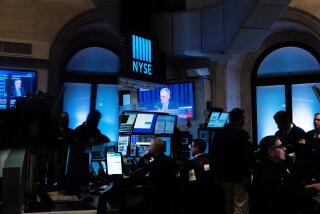Taking It All in Stride
- Share via
Georgi Krom, a 49-year-old Seattle graphics designer, has been investing her family’s modest savings and retirement money since the late 1980s and has seen it grow to more than $1 million through a combination of patience, caution and nerves of steel--qualities she says she’s not about to abandon now, when the market is tough.
“It’s depressing because it’d be nice to think if I’d just sold everything a year ago, I’d have more money than I do now. But that’s risky too, because you have to pay commissions, and you never know when the market is going to go up again. I guess I feel if you have a long-term investment strategy, you shouldn’t necessarily panic. People are probably selling now, when they probably should be thinking about buying.... We have better prices right now than we have had in a long time.”
Krom and her husband, Steve, a tool machinist who owns a small hauling company, have two teenage boys, 13 and 16, who are approaching college age. For them, she has put money in short-term corporate bonds, cash and some zero-coupon bonds she bought a few years ago. When her father died recently, Krom paid off her mortgage rather than making a big stock investment.
“It just felt good having no mortgage,” she said.
But overall, about 67% of the family savings account and Steve’s individual retirement account is invested in the stock market. Krom looked suspiciously at others around her, especially in the Pacific Northwest, who were investing heavily in technology stocks over the last decade.
“My husband’s sister invested all of her money with a broker in tech stocks, and she absolutely wiped out her retirement fund,” Krom said. “Hundreds of thousands of dollars went down the drain because she was so convinced that tech stocks were the way to go; that was the new economy. I said I was not comfortable with that, and I wanted to make my own decisions. I liked companies that had good products and a stable outlook.”
Krom does have more than a thousand shares of Microsoft stock, which she bought on a cost basis of $5 a share. Even with the recent downturns, Microsoft Corp. is trading at $49.56 a share and is likely to remain a good investment, Krom believes. “They execute very well, they have a lot of cash, they have no debt, they’re a very healthy technology company, and I wouldn’t sell them.”
But most of the rest of her portfolio is old standards: General Electric Co., Pfizer Inc., Washington Mutual Inc.
“I think it’s kind of goofy when people pay enormous prices for companies that don’t have good earnings,” she said. “My philosophy has always been companies with good earnings growth that are good, solid companies, and if they go down in price because people are selling them off, if they are good quality, you should add to them.”
*
Kim Murphy
More to Read
Inside the business of entertainment
The Wide Shot brings you news, analysis and insights on everything from streaming wars to production — and what it all means for the future.
You may occasionally receive promotional content from the Los Angeles Times.










